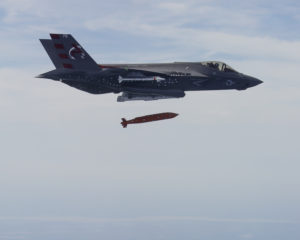
An F-35C Lightning II test aircraft conducts the first separation of a Joint Standoff Weapon C from an F-35 Joint Strike Fighter. JSOW C will come standard in the F-35 Block 3F configuration. (Photo: U.S. Navy)
The U.S. Navy is reporting that the final developmental test was completed to integrate Raytheon’s Joint Standoff Weapon C (JSOW C-1) with the F-35 carrier variant, the F-35C. The deployment of the JSOW on the F-35C is on schedule for 2019. The F-35C with the JSOW will be able to eliminate the toughest ground targets from a distance of more than 100 kilometers. The new system will be positioned inside the jet’s internal weapons, maintaining the platform’s stealth profile. The extended range of the JSOW C coupled with the F-35C’s massive internal fuel capacity (20,000 pounds the largest of the three F-35 variants), will help extend the reach of Carrier Strike Groups.
Raytheon Company (NYSE: RTN) and the U.S. Navy completed the final developmental test to integrate the Joint Standoff Weapon C onto the F-35 Joint Strike Fighter’s C variant, keeping the low-cost, air-to-ground missile on track for full deployment in 2019.
The JSOW glide weapon uses a GPS-inertial navigation system with an imaging infrared seeker that can identify and track targets autonomously. JSOW C weighs 1,000 pounds and is effective against high-value land targets at ranges greater than 70 nautical miles, day or night, and in adverse weather conditions.
“With JSOW C in its internal weapons bay, the Navy’s F-35C can now eliminate the toughest ground targets from significant standoff ranges,” said Mike Jarrett, vice president of Raytheon Air Warfare Systems. “JSOW’s advanced warhead and smart fuse provide fighter pilots with plenty of flexibility against hard and soft targets — plus, it has many programmable effects.”
Lockheed Martin, manufacturer of the F-35, and the F-35 Joint Program Office participated in the latest test, which took place on the Navy’s China Lake ranges in California.
Source: Raytheon
E.J. Smith - Your Survival Guy
Latest posts by E.J. Smith - Your Survival Guy (see all)
- Rule #1: Don’t Lose Money - April 26, 2024
- How Investing in AI Speaks Volumes about You - April 26, 2024
- Microsoft Earnings Jump on AI - April 26, 2024
- Your Survival Guy Breaks Down Boxes, Do You? - April 25, 2024
- Oracle’s Vision for the Future—Larry Ellison Keynote - April 25, 2024















